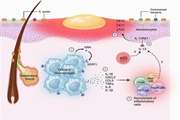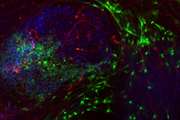Researchers identify cellular pathways whose dysregulation leads to acne lesions
Researchers identify cellular pathways whose dysregulation leads to acne lesions
Acne is the most common dermatological condition worldwide and has been shown to have significant psychological effects on suffers sufferers, especially teenagers. While the condition involves excess production of lipids in the hair follicles, keratinocyte hyperkeratinization, bacterial interaction and a host of inflammatory responses involving macrophages, little has been understood about the cascade of dysregulated signaling pathways -- the cell-to-cell communication -- those results in acne-affected skin.
New CAR-T cell therapy shows promise for hard-to-treat cancers
New CAR-T cell therapy shows promise for hard-to-treat cancers
Researchers at the University of Colorado Anschutz Medical Campus have successfully developed a supercharged iteration of CAR-T cell therapy that can enhance the effectiveness and longevity of the cells, particularly against cancer cells that are harder for prior CAR-T therapies to detect and fight. The study was published in the journal Cancer Cell. "This next-generation approach, called ALA-CART (adjunctive LAT-activating CAR-T cells), optimizes CAR-T cells to more effectively eliminate cancer cells, including those that have been able to hide from traditional CAR-T cells," said Catherine Danis, PhD, lead author and postdoctoral fellow at the University of Colorado School of Medicine.
Important step forward in stem cell therapy for rare bowel disease
Important step forward in stem cell therapy for rare bowel disease
A new study led by researchers at UCL and the University of Sheffield, has demonstrated the potential of stem cell therapy to treat those with Hirschsprung disease.
Using stem cell-derived heart muscle cells to advance heart regenerative therapy
Using stem cell-derived heart muscle cells to advance heart regenerative therapy
Regenerative heart therapies involve transplanting cardiac muscle cells into damaged areas of the heart to recover lost function. However, the risk of arrhythmias following this procedure is reportedly high. In a recent study, researchers from Japan tested a novel approach that involves injecting 'cardiac spheroids,' cultured from human stem cells, directly into damaged ventricles. The highly positive outcomes observed in primate models highlight the potential of this strategy
New technique for manipulating stem cells opens door to novel treatments
New technique for manipulating stem cells opens door to novel treatments
A new technique developed by McGill researchers for mechanically manipulating stem cells could lead to new stem cell treatments, which have yet to fulfill their therapeutic potential
Circulating microRNAs likely as effective as A1C for predicting type 2 diabetes in youth
Circulating microRNAs likely as effective as A1C for predicting type 2 diabetes in youth
Type 2 diabetes in young people ages 10 to19 has more than doubled in the past 20 years, yet it remains difficult for physicians to predict who will be diagnosed and who will improve with treatment. A newly published study from the University of Oklahoma shows that measuring the circulating abundance of microRNAs -- which affect insulin-producing beta cells in the pancreas -- is likely as effective as measuring the level of sugar in the blood for determining how a young person with the condition will fare







